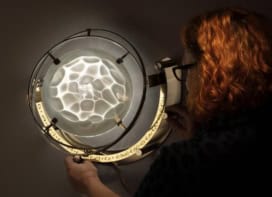Looming large over the UK’s tranquil Cheshire countryside, the Lovell radio telescope with its 76 m-diameter steerable dish is a beacon of science and engineering. This summer, it was transformed into a projection screen for an audiovisual artwork, using live data received from pulsars. The work, by Japanese artist Daito Manabe, was part of the Blue Dot Festival, an annual event in which the Jodrell Bank Observatory plays host to musicians, artists and a range of science communicators. Andrew Glester reports from this year’s festival for the October episode of the Physics World podcast.
2017 marks a couple of important anniversaries for the astrophysics community at Jodrell Bank. First, it is the 60th anniversary of the first light of the Lovell Telescope, which was the largest steerable dish telescope in the world (it is still the third largest). Second, it is the 50th anniversary of the first detection of pulsars being made by Dame Jocelyn Bell Burnell who was then a PhD student at the University of Cambridge.
The telescope takes its name from Sir Bernard Lovell who founded the Jodrell Bank Observatory in 1945. Over the decades, this astrophysics hub has been a valuable tool for studying various astrophysical objects and it even played a role in tracking events during the Space Race. Today it is the HQ of the Square Kilometre Array, a distributed telescope array that promises to usher in a new era in radio astronomy.
In recent years, Jodrell Bank has also developed a significant science-outreach programme, including the Jodrell Bank Discovery Centre, which opened in 2011 and now attracts thousands of visitors every year. The Blue Dot Festival is an extension of this and has been graced by music acts including Elbow, Sigur Rós and the Flaming Lips. The festival also features the winning work of the COSMOS art–science project, a collaboration between Jodrell Bank, Blue Dot Festival and the arts organization Abandon Normal Devices.
This year’s winning artist was Daito Manabe from Tokyo, an audiovisual artist whose specialisms include the visualization of data. Among his previous collaborators is the Icelandic popstar Björk. In this latest project, Manabe collaborated with astrophysicists at Jodrell Bank to transform pulsar data (live and archival) into sounds and images projected onto the Lovell dish. In this podcast, Glester experiences the event and discusses the project with Manabe. You can also hear what the rest of the festival-goers thought of this otherworldly experience.


